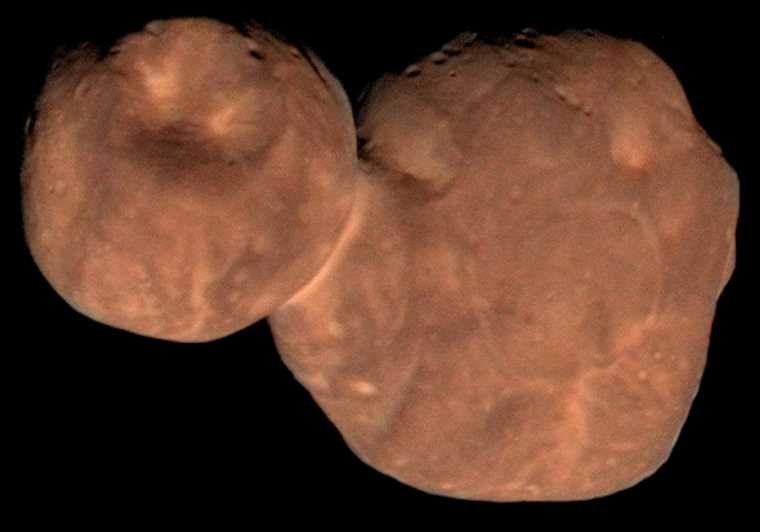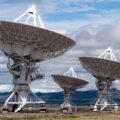A new study by researchers from Brown University and the SETI Institute of an object nicknamed “Space Snowman” is reportedly “shaking up” what scientists thought they knew about distant objects in the far reaches of the solar system.
Officially named Kuiper Belt Object 486958 Arrokoth, the researchers say the double-lobed object at the edge of our solar system may contain stores of ice deep within its interior from over 4.6 billion years ago when the solar system formed. Perhaps even more surprising, the researchers believe other Kuiper Belt objects (KBOs) may also contain these ancient ices from the dawn of the solar system.
The study’s results, published in the journal Icarus, are expected to inform future missions, including a sample return mission designed to help unlock the secrets of life on Earth.
Space Snowman May Not Be the Only KBO Containing Ancient Ice
“We’ve shown here in our work, with a rather simple mathematical model, that you can keep these primitive ices locked deep within the interiors of these objects for really long times,” said Sam Birch, a planetary scientist at Brown and one of the paper’s co-authors. “Most of our community had thought that these ices should be long lost, but we think now that may not be the case.”
If true, these ancient ice stores hidden within Space Snowman and other KBOs could offer critical information to scientists studying the formation of our planets and moons, as well as the dawn of Earth life itself.
Much of the previous skepticism came from the wide use of thermal evolutionary models applied to the solar system’s creation that, the researchers say, “failed to account for the longevity of ices that are as temperature sensitive as carbon monoxide.” This led Birch and his co-author Orkan Umurhan, a senior research scientist at the SETI Institute, to design and create their own model, which revealed that it is more likely that these highly volatile ancient ices “stick around” much longer than previously thought.
“We are basically saying that Arrokoth is so super cold that for more ice to sublimate — or go directly from solid to a gas, skipping the liquid phase within it — that the gas it sublimates into first has to have travel outwards through its porous, sponge-like interior,” Birch said.
Unfortunately, Birch explained, if you want to move the gas, you also have to sublimate the ice surrounding it. His models show that for many KBOs, including Space Snowman, there isn’t enough solar energy to accomplish this.
“So what you get is a domino effect: it gets colder within Arrokoth, less ice sublimates, less gas moves, it gets even colder, and so on,” Birch explained. Eventually, everything just effectively shuts off, and you’re left with an object full of gas that is slowly trickling out.”
If their models are correct, the researchers say a large number of KBOs besides Space Snowman could contain ancient ices, which remain effectively dormant within the object’s interior unless they experience an orbital shift that moves them closer to the sun. In fact, the researchers suspect that this is why KBOs that do experience an orbital shift that brings them closer to the sun explode so violently. The ancient ices inside these objects suddenly sublimate to gas and expand, essentially turning them into comets.
“The key thing is that we corrected a deep error in the physical model people had been assuming for decades for these very cold and old objects,” said Umurhan. “This study could be the initial mover for reevaluating the comet interior evolution and activity theory.”
Research Will Inform Upcoming Missions to Retrieve Samples from Comets
Although the study is based on theoretical models, the researchers get the opportunity to apply their expertise in the near future. That’s because both Birch and Umurhan are listed as co-investigators for NASA’s upcoming Comet Astrobiology Exploration Sample Return (CAESAR) mission, which could launch as soon as August of this year.
According to NASA, “The Comet Astrobiology Exploration Sample Return (CAESAR) mission will acquire and return to Earth for laboratory analysis a minimum of 80 grams of surface material from the nucleus of comet 67P/Chur-yumov-Gerasimenko (67P). CAESAR will characterize the surface region sampled, preserve the collected sample in a pristine state, and return evolved volatiles by capturing them in a separate gas reservoir.”
As the name’s inclusion of “astrobiology” implies, one of the goals of CAESAR is to look for gins of life or its building blocks at the dawn of the solar system’s creation. Although the mission isn’t expected to actually land on a comet until 2038, the researchers say their new study shows that sample return missions like CAESAR may contain a wide range of tantalizing clues that are just waiting to be unlocked.
“There may well be massive reservoirs of these primitive materials locked away in small bodies all across the outer solar system — materials that are just waiting to erupt for us to observe them or sit in deep freeze until we can retrieve them and bring them home to Earth,” Birch said.
Christopher Plain is a Science Fiction and Fantasy novelist and Head Science Writer at The Debrief. Follow and connect with him on X, learn about his books at plainfiction.com, or email him directly at christopher@thedebrief.org.

